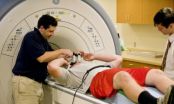(Press-News.org) The way melanoma cells use the immune system to spread and develop into lung tumors may lead to a therapy to decrease development of these tumors, according to Penn State researchers.
"Melanoma is the most aggressive and metastatic form of skin cancer," said Gavin Robertson, professor of pharmacology, pathology, dermatology and surgery in the Penn State College of Medicine. "Therefore, identifying proteins and molecular mechanisms that regulate metastasis is important for developing drugs to treat this disease."
Metastasis is a complex process in which cancer cells detach from the primary tumor and migrate to other sites in the body by traveling through the lymphatic or blood circulatory systems. Researchers in the Foreman Foundation Melanoma Research Laboratory at Penn State developed a model to determine why the roughly one million tumor cells shed daily from a 1-gram melanoma tumor do not form more metastases in the lungs.
After intravenously injecting 1 million human melanoma cells in a mouse, Robertson and colleagues observed entrapment of many of these cells in the lung vessels. Within 24 hours, however, few cells were still present in the lungs.
"In this study, we show that entrapped, circulating melanoma cells can use a person's own immune cells -- specifically a type of white blood cell called neutrophils -- to control lung metastasis development," Robertson said. After injecting the mice with neutrophils an hour following the melanoma cell injection, cancer cell retention was increased in the lung by about three times.
Melanoma cells produce and secrete high levels of a protein called IL-8, which is used to attract neutrophils.
"For patients, this is important because a therapy preventing circulating melanoma cells from secreting IL-8 would have the potential to decrease lung metastasis development by about 50 percent by disrupting interaction of the cancer cells with neutrophils," Robertson said. "Metastases form by proteins on the melanoma and neutrophils interacting and forming physical connections. These connections promote anchoring of the melanoma cells to the lung vessel walls, enabling the cancer cells to migrate through the wall to form lung metastases."
Decreasing the secretion of IL-8 limits the interaction of melanoma cells with neutrophils, dropping the number of melanoma cells retained in the lungs by about half.###
Findings were published in the journal Cancer Research. Funding for the study was provided by the National Institutes of Health and the Foreman Foundation for Melanoma Research.
Other authors on the report are Penn State graduate students Sung Jin Huh of the Department of Pharmacology and Shile Liang of the Department of Bioengineering, assistant professor Arati Sharma of the Department of Pharmacology, and professor Cheng Dong, who all are members of the Melanoma Therapeutics Program at Penn State.
END
CAMBRIDGE, Mass. -- By creating a better way to see molecules at work in living brain cells, researchers affiliated with MIT's Picower Institute for Learning and Memory and the MIT Department of Chemistry are helping elucidate molecular mechanisms of synapse formation. These studies could also help further understanding of how synapses go awry in developmental diseases such as autism and Fragile X syndrome. The study will appear in the Oct. 7 issue of Cell.
Using the new technique, which is more accurate and sensitive than existing methods, the researchers found that ...
WASHINGTON—October 7, 2010—The U.S. invested $139 billion last year in health research from all public and private sources, according to Research!America's latest annual estimate. That amount represents only 5.6% of the $2.47 trillion overall U.S. health spending in 2009—or 5.6¢ of every health dollar—which varies no more than 0.2% from 2005 levels.
The estimate is available here: http://www.researchamerica.org/uploads/healthdollar09.pdf.
The 2009 investment grew by only 0.1% over 2008. This small increase can be attributed largely to the federal stimulus funding ...
NASA satellites have collected data as the Atlantic Ocean's Tropical Depression 17 has undergone two changes in less than 24 hours. Since Oct. 6, the depression has strengthened and has tropical storm-force winds and has morphed from a sub-tropical storm into a tropical storm.
After a United States Air Force Reserve reconnaissance flight subtropical depression seventeen was upgraded by the National Hurricane Center (NHC) to subtropical storm Otto on Oct. 6 at 5 p.m. EDT (2100 UTC). On Oct. 6 and 7, NASA's TRMM and Aqua satellites were flying overhead measuring very cold, ...
Saturn's icy moon Enceladus should not be one of the most promising places in our solar system to look for extraterrestrial life. Instead, it should have frozen solid billions of years ago. Located in the frigid outer solar system, it's too far from the sun to have oceans of liquid water -- a necessary ingredient for known forms of life -- on its surface.
Some worlds, like Mars or Jupiter's moon Europa, give hints that they might harbor liquid water beneath their surfaces. Mars is about 4,200 miles across and Europa almost 2,000 miles across. However, with a diameter ...
PHILADELPHIA - Heart muscle cells do not normally replicate in adult tissue, but multiply with abandoned during development. This is why the loss of heart muscle after a heart attack is so dire—you can't grow enough new heart muscle to make up for the loss.
A team of researchers at the University of Pennsylvania School of Medicine describe the interconnections between three-molecules that control fetal, heart-muscle-cell proliferation in a mouse model that will help cardiologists better understand the natural repair process after heart attacks and help scientists learn ...
CHAMPAIGN, Ill. — University of Illinois chemistry professor Alexander Scheeline wants to see high school students using their cell phones in class. Not for texting or surfing the Web, but as an analytical chemistry instrument.
Scheeline developed a method using a few basic, inexpensive supplies and a digital camera to build a spectrometer, an important basic chemistry instrument. Spectrophotometry is one of the most widely used means for identifying and quantifying materials in both physical and biological sciences.
"If we want to measure the amount of protein in ...
An approach pioneered by researchers at North Carolina State University gives scientists new insight into the way silicon bonds with other materials at the atomic level. This technique could lead to improved understanding of and control over bond formation at the atomic level, and opportunities for the creation of new devices and more efficient microchips.
Manufacturers build silicon-based devices from layers of different materials. Bonds – the chemical interaction between adjacent atoms – are what give materials their distinctive characteristics. "Essentially, a bond ...
New Haven, Conn.—A team of Yale University scientists has engineered the cell wall of the Staphylococcus aureus bacteria, tricking it into incorporating foreign small molecules and embedding them within the cell wall.
The finding, described online in the journal ACS Chemical Biology this week, represents the first time scientists have engineered the cell wall of a pathogenic "Gram-positive" bacteria—organisms responsible not only for Staph infections but also pneumonia, strep throat and many others. The discovery could pave the way for new methods of combating the bacteria ...
WEST LAFAYETTE, Ind. - A study by researchers at Purdue University suggests that some high school football players suffer undiagnosed changes in brain function and continue playing even though they are impaired.
"Our key finding is a previously undiscovered category of cognitive impairment," said Thomas Talavage, an expert in functional neuroimaging who is an associate professor of biomedical engineering and electrical and computer engineering and co-director of the Purdue MRI Facility.
The findings represent a dilemma because they suggest athletes may suffer a form ...
(Garrison, NY) The researcher whose revelations about unethical U.S. studies on syphilis in Guatemala in the 1940's led to apologies from the Obama administration last week has written a commentary for Bioethics Forum, the Hastings Center's online publication. She calls for the need to learn from history to better protect human subjects in the developing world.
Susan M. Reverby, a professor at Wellesley College, describes how she unearthed documents about the study by accident while doing research for a book on the Tuskegee syphilis study. The documents, hidden in the ...



